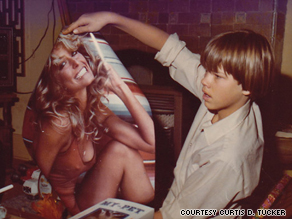
The picture says it all.
The shot of 14-year-old Curtis D. Tucker shows him unrolling one of his birthday treasures in 1976, mouth slightly agape and eyes intensely focused on the gift. The present was one he had fervently requested from his parents and a hot item for many a young, red-blooded male during that bicentennial year: a poster of Farrah Fawcett (then known as Farrah Fawcett-Majors). “I was a huge Farrah fan,” said Tucker, now a cartoonist and entrepreneur living in Enid, Oklahoma. “I had started collecting all of the magazines and pictures and I was basically pinning up every picture that came out of every magazine. Then along came that poster.” “That poster” reportedly became the best-selling of all time — with more than 12 million copies sold — and helped make Fawcett one of the last great pinups. A private funeral is scheduled Tuesday at the Cathedral of Our Lady of the Angels in downtown Los Angeles, California, for the actress who died at the age of 62 from cancer.
Don’t Miss
Funeral for Farrah Fawcett set for Tuesday
Friends, loved ones remember Farrah Fawcett
EW.com: Photographer remembers iconic shoot
With her famously thick blond hair, red swimsuit, and smile as big and bright as the California sun, the actress was the epitome of the wholesome, all-American girl. “She was full of life and so happy with that blond hair and that huge smile,” said Tucker, who isn’t sure if he still has the poster in his attic. “Without that poster, I don’t think she would have become what she was.” That freshness and beauty is what landed her poster on Tucker’s, and countless others’, bedroom walls. Maria Elena Buszek, the author of “Pin-up Grrrls: Feminism, Sexuality, Popular Culture,” said pinups “straddled the line between portraiture and pornography” and included early stage actresses, the famed models of Alberto Vargas and the most famous pinup of all, Bettie Page. Fawcett has her place in pinup history, said Buszek, an assistant professor of art history at Kansas City Art Institute, School of Liberal Arts. “The Farrah Fawcett poster really is one of the last iconic pinup images of the 20th century,” Buszek said. “By the 1970s, because of the sexual revolution and mores about sexuality becoming looser in the west, the pinup does start to become more nostalgic.” When the photo was taken, Fawcett had not yet become one of “Charlie’s Angels,” the role which helped make her a star. She was instead better known for her commercials and ads, most notably — and not surprisingly — for Wella Balsam shampoo. Photographer Bruce McBroom shot the now iconic image and told Entertainment Weekly that the starlet was at the time a young innocent from Texas who did her own hair and makeup for the shoot. “She had no idea of how beautiful and how attractive she was, I’m sure,” McBroom recalled. “She was just like apple-pie, girl-next-door kind of girl, and in all the years I knew her she never changed.” Now Fawcett’s image, which was considered racy at the time, is a huge part of nostalgia. Ken Leicht, a manager of Hollywood Book and Poster Company in Los Angeles, said that before Fawcett’s death, the poster was most in demand from production companies looking to stage the 1970s. “That poster, that shot of her, is just one of the definitive images of that time,” Leicht said. “Most of the time with the posters, the teen girls are driving the market, and Farrah is probably one of the last ones that was for the guys.” Leicht said actresses today, with the exception of a few like Pamela Anderson, don’t really opt to market themselves using posters anymore. Matt Delzell, group account director for marketing and promotions agency The Marketing Arm, said that eventually the pinup transitioned more into supermodel pictures with the likes of Cindy Crawford, Claudia Schiffer and Elle MacPherson, as well as the Sports Illustrated swimsuit issue. Fawcett had the crossover appeal that went beyond just being a model, Delzell said. “The poster came along at a time when posters were popular and she had the right photographer and took the right photo,” Delzell said. It certainly was the right shot for cartoonist Curtis D. Tucker. He wasn’t a big fan of “Charlie’s Angels,” he said, so he wasn’t that distressed when Fawcett left after only a year. After all, he was still able to keep her close. “The poster was something you had at home that you could look at every day,” said Tucker, who kept the image up for several years. “I collected a few other pictures of some of the other Angels, but there wasn’t anybody else after Farrah. She was the last.”